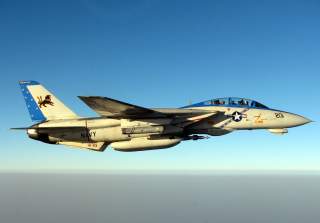When U.S. Navy F-14 Tomcats Attacked Saddam Hussein’s Presidential Yacht
A true story.
Operation Iraqi Freedom (OIF) was a huge success for the F-14 squadrons committed to the action. Tomcat pilots and radar intercept officers (RIOs) flew myriad missions in their 52 jets, performing air defence, forward air controlling (airborne), strike coordination, reconnaissance and photo-reconnaissance missions and precision bombing across Iraq.
As told by Tony Holmes in his book U.S. Navy F-14 Tomcat Units of Operation Iraqi Freedom, the dropping of ‘dumb’ bombs from an F-14 was instead a rare occurrence in OIF, although two crews from VF-2 “Bounty Hunters” enjoyed spectacular results with four 500-lb Mk 82 ‘slicks’ on Mar. 27, 2003. The RIO in one of the jets was Lt(jg) Pat Baker;
“We had been conducting a standard TARPS mission along the Euphrates River, looking at two or three air defence sites, as well as a possible command and control facility that our intelligence folks thought was in the area. They needed photos of the latter in order to confirm its purpose for target assignment. What was different for us that day was the fact that the ATO gave us two jets armed with a pair of Mk 82 bombs apiece. This was the first time VF-2 had carried such a mixed load, featuring both bombs and a TARPS pod. This allowed us to act as a stop gap bomber should anyone need immediate on-call support while we were over southern Iraq.
“I was in the back seat of the Dash 2 jet, leaving the RIO in the lead aircraft to run the flight in terms of coordinating the navigation for all the photo-run targets. My job was to work the radios for my pilot, Lt Sean Mathieson, checking with AWACS controllers and FACs on the ground as to whether anyone needed our bombs. Having bounced around through a series of different nets on various frequencies, I ended up talking to a British Army FAC near Basra. He wanted us to head down the Shatt al-Arab waterway and attack Saddam’s presidential yacht, which had been hit by a Maverick fired from an S-3B two days earlier and then missed by two LGB-toting F/A-18s. By the time I contacted the FAC, we had finished our reconnaissance runs and were about to head south over the NAG to hit the tanker and then head back to the carrier.”
Named Al Mansur (The Victor), Saddam Hussein’s presidential yacht had been one of the world’s largest and most impressive vessels of its kind prior to it appearing on the CAOC’s ATO. Eight decks high and 350 feet long, the Finnish-built ship weighed 7359 tons and looked more like a cross-channel ferry than a private boat. It boasted five expansive state cabins for Saddam and his family, and there was even a secret escape route leading from the president’s room to a submarine pod. Launched in 1982, it was the largest vessel in the Iraqi Navy, but it had no military use. The ship was designed to Saddam’s specifications and decorated in marble and exotic woods with silver and gold fittings. Permanently staffed by 120 Special Republican Guard troops, the vessel was moved from the port of Umm Qasr to Basra just days before the war began in an effort to afford it better protection – the order for the move was issued directly by Saddam himself. The Al Mansur had been targeted for destruction because the CAOC had received reports that the vessel’s extensive radio suite was being used for battlefield communications.
Baker continues: “The FAC was not actually near the yacht, so he was relaying information that he had recently received to us when he was describing where the vessel was situated. We were at high altitude, scouring the port facility through binoculars looking for the yacht. We spotted the burnt-out warehouses that had been hit in error by the F/A- 18s the previous day, and these served as a marker for the yacht. It was moored between two freighters, with a third half-sunken vessel nearby. The Maverick damage was clearly visible, with smoke rising from the vessel’s superstructure.
“The lead jet, flown by Lt Mark Callari and Lt(jg) Jeff Sims (RIO), rolled in first, while we provided high cover for it — we were not sure of the AAA or SAM threats in the area. Their first bomb hit the bow, and having been unopposed in the attack, they came in and dropped the second, which struck the vessel just forward of amidships.
`The lead jet then swapped places with us, Lt Mathieson (Baker’s pilot) following his CCIP (Continuously Computed Impact Point) crosshairs in the HUD, which were centred on the vessel. We dropped both of our bombs in the same attack, one hitting the hull just above the waterline and the other disappearing amongst the yacht’s superstructure. When we left the target the ship was on fire, although we knew we had not inflicted sufficient damage to sink it as we were carrying the wrong type of ordnance. Assuming that we were going to be supporting ground troops, we had had our Mk 82s fitted with instantaneous fuses. Therefore, the weapons exploded as soon as they came into contact with the ship, rather than burying themselves into the heart of the vessel before detonating.
“I never got to see my bombs hitting home in all the LGB and JDAM missions that we flew in OIF. However, on this occasion, thanks to the diving, rolling and pulling off of the target that we had had to do in order to accurately deliver our Mk 82s, I was able to see the two little grey ‘blurs’ that were our bombs hitting the ship as I peered back over my shoulder at the target.”
This article by Dario Leone originally appeared on The Aviation Geek Club in 2018.
Image: Wikipedia.

